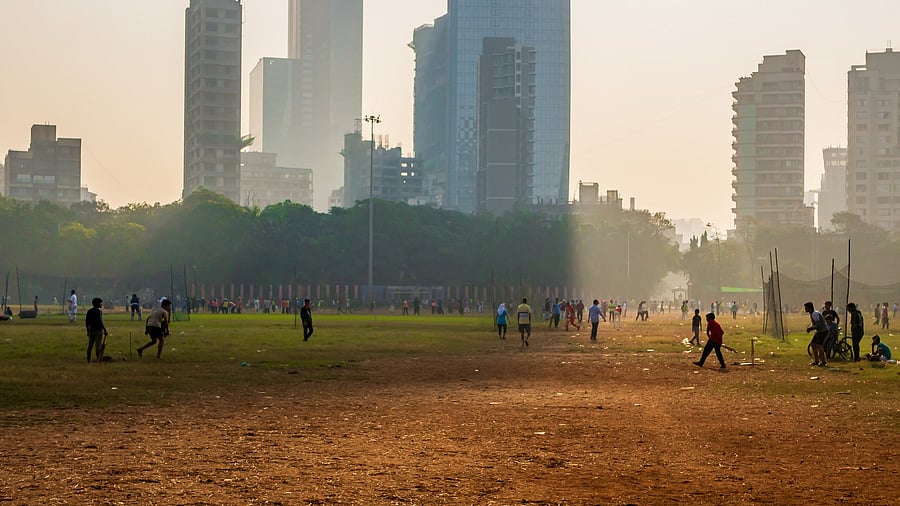
Representative image showing children play cricket at Shivaji Park.
Credit: iStock Photo
Mumbai: From being a venue for gatherings of freedom fighters during the British Raj to becoming the focal point of the Samyukta Maharashtra Chalval to being the cradle of cricket, which saw players like Sachin Tendulkar, Dadar's Shivaji Park in the heart of Mumbai is one of the most sought-after venues for political rallies.
History, politics and cricket go together in Shivaji Park.
Officially known as the Chhatrapati Shivaji Maharaj Park, the circular ground has seen India pre-and-post-1947 and witnessed the transformation of Bombay to Mumbai and its mills-to-malls story.
Mumbai’s who’s who - including writers, artistes, filmmakers, sportspersons, politicians, celebrities stay around Shivaji Park.
The edge of the park turns into a katta, where people sit and talk on myriad topics.
The inner circumference of the park is 1.17 kilometres and area is around 112,937 square-metres (27.907 acres) - making it a great venue for multiple purposes.
With the announcement of the Lok Sabha polls, political parties have already applied to use the park as a venue to the BrihanMumbai Municipal Corporation (BMC), which administers the large ground.
The Congress-led I.N.D.I.A. sounded the bugle from Shivaji Park around a fortnight ago. Among those who have applied include BJP, Shiv Sena, Shiv Sena (UBT), MNS, and NCP.
“Shivaji Park is linked to the history of Mumbai and there cannot be any better venue,” said Ajit Joshi, a journalist-writer, who knows several interesting facets of Mumbai.
Besides being a venue for gatherings of freedom fighters in British India, after independence, in 1947, Shivaji Park was the focal point of the Samyukta Maharashtra Chalval (movement) that led to the present Maharashtra state being formed in 1960.
On June 19, 1966, the late cartoonist and politician Balasaheb Thackeray founded Shiv Sena for the larger cause of welfare and interests of the Marathi manoos. On October 23, 1966, Marmik, a cartoon-centric magazine edited by Balasaheb, published a note announcing a rally at Shivaji Park at 5.30 pm on October 30, to observe Dussehra – the festival Hindus hold to celebrate the victory of good over evil, also known as Vijaya Dashami. As announced, the rally was held at Shivaji Park - which the Shiv Sainiks call ‘Shivtirth’ - and Balasaheb, an orator-par-excellence, addressed the gathering.
Shivaji Park is also very important for the Hindutva movement - when Balasaheb took up the cause of Hindus and the Ram temple - and BJP stalwarts like Atal Bihari Vajpayee and Lal Krishna Advani addressed the masses from this venue. Socialist leader George Fernandes too had addressed rallies here.
There are many important places around Shivaji Park. The Mayor's bungalow is just opposite the Park - where a memorial dedicated to Balasaheb is coming up. In fact, the last rites of Balasaheb and late Lata Mangeshkar, the Nightingale of India, were held inside this park. A small memorial of Balasaheb is located here and on the other side, there is a bust of Meenatai Thackeray, popularly known as Masaheb.
Chaityabhoomi, where the last rites of Dr Babasaheb Ambedkar was performed is just a stone's throw distance away and so is Swatantryaveer Savarkar Rashtriya Smarak, which honours the freedom fighter and Hindutva icon.
The Shivaji Park has cricket nets, tennis courts, mallakhamb corner, football ground, a gymnasium - Samarth Vyayam Mandir, the Scout's Pavilion, a park for elders, Shivaji Park Gymkhana, and the Bengal Club, a Kali-bari (temple for Goddess Kali) and a Ganesh-mandir (temple for Lord Ganesha).
There is an imposing statue of Shivaji Maharaj which can be seen from all sides.